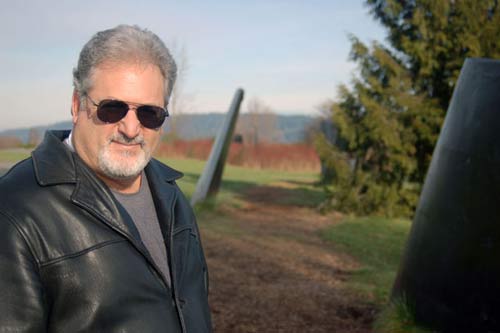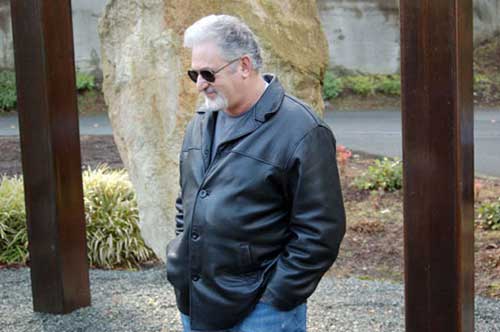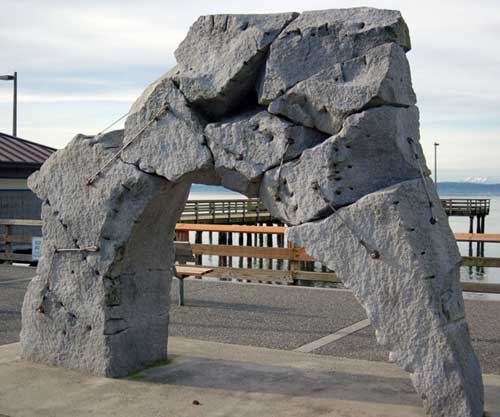
 Sculpture News at SculptSite.com
Sculpture News at SculptSite.com
John T. Young Sculpture |
| The Huffington Post by Darby Roach Sculptor John T. Young, Turning Swords into PlowsharesA pod of killer whales breach the surface, the sleek black line of dorsal fins is arrayed in a graceful curve, starkly beautiful in the early morning light. The only difference between this and other Pacific Northwest pods is that instead of residing in the chilly waters of Puget Sound, this family of orcas swim the lush green lawns of Seattle's Warren G. Magnuson Park. John T. Young is a sculptor and professor of art at the University of Washington in Seattle. His work, "The Fin Project: From Swords into Plowshares", uses parts from decommissioned nuclear attack submarines to create a work of public art that is at once visceral and intellectual. |
 |
| I'm standing with John near one of his "orcas;" we're talking about how "Swords into Plowshares" came about. John is cheery this morning, he laughs easily, "A friend of mine heard that the Navy was trying to get rid of some nuclear attack submarine diving planes," he says, "you see, they're filled with a material that makes them pretty much impossible to melt down for scrap, so salvage dealers didn't want them. I saw a photo and I knew right away what to do with them."
"It happened that quick?" I ask. John runs his hand along the rough surface of one of the orcas. "It was so obvious to me. I saw it in my mind's eye. Take these diving planes -- which, when they're on the subs are horizontal -- turn them vertically and you have a pod of killer whales." I look up and down the line of fins protruding from the grass at a height of from 4 to 12 feet. From this vantage point and the way the fins are placed and angled, I don't have to use much imagination to get the feeling that I'm actually in the midst of a pod of killer whales. I have to admit, though, I'm not sure I'd have made the same connection that John did when he first saw the diving planes in their original horizontal orientation. |
 |
But then, I don't have John's eye. Swords into Plowshares is only one of John's many public works of art. He's done a version of his Swords into Plowshares at the Pelican Harbor Park in Miami, Florida, and he has plans for another related work in Russia. His hope is that similar "pods" can be created around the country and the world as symbols for peace on a global scale. But not all John's art takes on such serious global issues. Another work, "Temple of the Stones," is a bit more whimsical. In "Temple of the Stones," John has figured out how to make ten-ton boulders float exactly the way big rocks don't. The boulders are suspended a few feet off the ground by cables from a steel superstructure so that you're able to move the granite monsters around with the tip of your finger. The result is almost surreal; as one boulder starts to sway, the others begin to pick up the frequency through the connecting cables and they move too. You can't help but smile. |
 |
In John's youth, he was a crackerjack rock climber and that sensibility to earth and stone has found expression in much of his work. To create "Arch," a rock and steel structure on the boardwalk at Redondo Beach in Seattle, John dynamited and fractured a 40-ton slab of solid rock then reassembled it (intentionally leaving a few parts out) like a jigsaw puzzle. "Creation is really an act of destruction," John says. "You have to tear something apart before you can create. I wanted to make something that was substantial but somehow fragile at the same time." |
 |
With more than 40 works of public art to his credit, John is as prolific as he is talented. His art more than meets our need for aesthetic satisfaction, but there are other layers to his work that stimulate the intellect and spark the imagination, too. When I ask why he is drawn to public art, he says, "Artists have a responsibility to contribute to the community. For me, the best way to do that is to put art where people can interact with it. I want to create experiences that bring people together around a common idea or theme." John is an enthusiastic proponent of art in public spaces. As well as being a world-renowned artist in his own right, he's an internationally recognized authority on sculpture and art in the public space. His recently completed program for public TV, titled You Call That Art?! can be viewed at www.youcallthatart.net. When I ask what plans he has for future projects, John tells me that he's been invited to propose a large-scale work for a new sculpture garden in Changchun, China, said to be the biggest of its kind in the world. "I'll be proposing one of my structurally dynamic pieces, but this time the work will have figurative components; a new genre and path for me." Looking at the body of John's work, one might be tempted to think that going figurative would be outside his comfort zone. But when you consider his mastery of form and concept, his amazing imagination and vision, you realize that venturing into unknown waters is what John is all about! |
 John T. Young a very creative sculptor. I really enjoy the simplicity of his sculpture. He says so much with so little! Isn't that the majic key to being a world renouned sculptor? Very nice article written by Darby Roach. |
More Sculpture News ....
Submit your SCULPTURE NEWS.
It's easy, just send us an e-mail
(click on Submit News in the left menu) with your pertinent information along with images, we'll take care of the rest. Sculpture makes our world a much better place in so many ways!
SculptSite.com, along with Sculptors and their creative genius all helping to bring the beauty and message of Sculpture to a hurried world.

